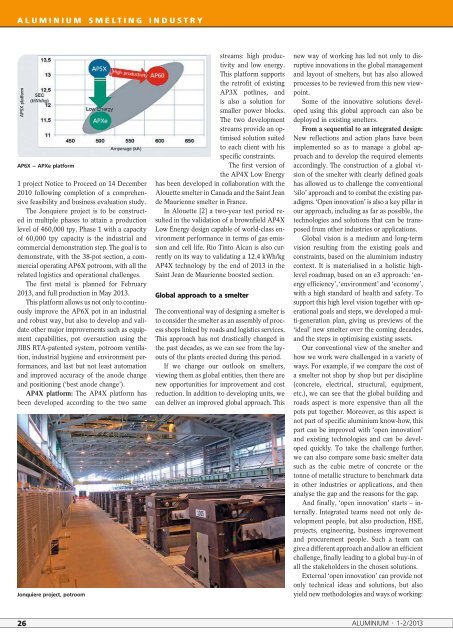special - ALUMINIUM-Nachrichten – ALU-WEB.DE
special - ALUMINIUM-Nachrichten – ALU-WEB.DE
special - ALUMINIUM-Nachrichten – ALU-WEB.DE
You also want an ePaper? Increase the reach of your titles
YUMPU automatically turns print PDFs into web optimized ePapers that Google loves.
<strong><strong>ALU</strong>MINIUM</strong> SMELTING INDUSTRY<br />
AP6X <strong>–</strong> APXe platform<br />
1 project Notice to Proceed on 14 December<br />
2010 following completion of a comprehensive<br />
feasibility and business evaluation study.<br />
The Jonquiere project is to be constructed<br />
in multiple phases to attain a production<br />
level of 460,000 tpy. Phase 1 with a capacity<br />
of 60,000 tpy capacity is the industrial and<br />
commercial demonstration step. The goal is to<br />
demonstrate, with the 38-pot section, a commercial<br />
operating AP6X potroom, with all the<br />
related logistics and operational challenges.<br />
The first metal is planned for February<br />
2013, and full production in May 2013.<br />
This platform allows us not only to continuously<br />
improve the AP6X pot in an industrial<br />
and robust way, but also to develop and validate<br />
other major improvements such as equipment<br />
capabilities, pot oversuction using the<br />
JIBS RTA-patented system, potroom ventilation,<br />
industrial hygiene and environment performances,<br />
and last but not least automation<br />
and improved accuracy of the anode change<br />
and positioning (‘best anode change’).<br />
AP4X platform: The AP4X platform has<br />
been developed according to the two same<br />
Jonquiere project, potroom<br />
streams: high productivity<br />
and low energy.<br />
This platform supports<br />
the retrofit of existing<br />
AP3X potlines, and<br />
is also a solution for<br />
smaller power blocks.<br />
The two development<br />
streams provide an optimised<br />
solution suited<br />
to each client with his<br />
specific constraints.<br />
The first version of<br />
the AP4X Low Energy<br />
has been developed in collaboration with the<br />
Alouette smelter in Canada and the Saint Jean<br />
de Maurienne smelter in France.<br />
In Alouette [2] a two-year test period resulted<br />
in the validation of a brownfield AP4X<br />
Low Energy design capable of world-class environment<br />
performance in terms of gas emission<br />
and cell life. Rio Tinto Alcan is also currently<br />
on its way to validating a 12.4 kWh/kg<br />
AP4X technology by the end of 2013 in the<br />
Saint Jean de Maurienne boosted section.<br />
Global approach to a smelter<br />
The conventional way of designing a smelter is<br />
to consider the smelter as an assembly of process<br />
shops linked by roads and logistics services.<br />
This approach has not drastically changed in<br />
the past decades, as we can see from the layouts<br />
of the plants erected during this period.<br />
If we change our outlook on smelters,<br />
viewing them as global entities, then there are<br />
new opportunities for improvement and cost<br />
reduction. In addition to developing units, we<br />
can deliver an improved global approach. This<br />
new way of working has led not only to disruptive<br />
innovations in the global management<br />
and layout of smelters, but has also allowed<br />
processes to be reviewed from this new viewpoint.<br />
Some of the innovative solutions developed<br />
using this global approach can also be<br />
deployed in existing smelters.<br />
From a sequential to an integrated design:<br />
New reflections and action plans have been<br />
implemented so as to manage a global approach<br />
and to develop the required elements<br />
accordingly. The construction of a global vision<br />
of the smelter with clearly defined goals<br />
has allowed us to challenge the conventional<br />
‘silo’ approach and to combat the existing paradigms.<br />
‘Open innovation’ is also a key pillar in<br />
our approach, including as far as possible, the<br />
technologies and solutions that can be transposed<br />
from other industries or applications.<br />
Global vision is a medium and long-term<br />
vision resulting from the existing goals and<br />
constraints, based on the aluminium industry<br />
context. It is materialised in a holistic highlevel<br />
roadmap, based on an e3 approach: ‘energy<br />
efficiency’, ‘environment’ and ‘economy’,<br />
with a high standard of health and safety. To<br />
support this high level vision together with operational<br />
goals and steps, we developed a multi-generation<br />
plan, giving us previews of the<br />
‘ideal’ new smelter over the coming decades,<br />
and the steps in optimising existing assets.<br />
Our conventional view of the smelter and<br />
how we work were challenged in a variety of<br />
ways. For example, if we compare the cost of<br />
a smelter not shop by shop but per discipline<br />
(concrete, electrical, structural, equipment,<br />
etc.), we can see that the global building and<br />
roads aspect is more expensive than all the<br />
pots put together. Moreover, as this aspect is<br />
not part of specific aluminium know-how, this<br />
part can be improved with ‘open innovation’<br />
and existing technologies and can be developed<br />
quickly. To take the challenge further,<br />
we can also compare some basic smelter data<br />
such as the cubic metre of concrete or the<br />
tonne of metallic structure to benchmark data<br />
in other industries or applications, and then<br />
analyse the gap and the reasons for the gap.<br />
And finally, ‘open innovation’ starts <strong>–</strong> internally.<br />
Integrated teams need not only development<br />
people, but also production, HSE,<br />
projects, engineering, business improvement<br />
and procurement people. Such a team can<br />
give a different approach and allow an efficient<br />
challenge, finally leading to a global buy-in of<br />
all the stakeholders in the chosen solutions.<br />
External ‘open innovation’ can provide not<br />
only technical ideas and solutions, but also<br />
yield new methodologies and ways of working:<br />
26 <strong><strong>ALU</strong>MINIUM</strong> · 1-2/2013
















